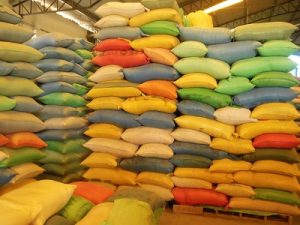Despite the severe drought from August to December last year, the quinoa crop appears to be much larger than anticipated. Recent statements from the Centro Internacional de la Quinoa (CIQ) suggest that production may be 82,500 tons. The remarkable recovery of the quinoa crop is attributed to late rains falling from December onwards in many areas. With the rains, many farmers are reported to have re-sown their fields with quinoa. The harvesting season was completed in June. If the figures from CIQ are confirmed, the quinoa crop would be larger than 75,000 tons they report for 2016. (The Ministerio de Desarrollo Rural y Tierras reports 65,500 tons for 2016.) In spite of the overall recovery, there are large differences in production between farmers and growing areas.
Reinaldo Quispe, agronomist at PROINPA, confirms that the production in 2017 is expected to reach a total volume of 80,000 – 85,000 tons. He bases these figures on information from the Instituto Boliviano de Comercio Exterior (IBCE). Official statistics will be available in November. The harvest has been completed, although in some cases the producers still need to thresh and ventilate the crop, which will continue until the end of July.
 Reinaldo explained that the quinoa harvest varies greatly from place to place. His observations are based on field visits, by himself and several colleagues from PROINPA, in different parts of the Altiplano. While the rains starting the agricultural season normally come in August and September, last year they only started in December. In many places farmers have re-sown quinoa in December and January, or even February. However, not all farmers did this. Officially November is the last month to sow quinoa in Bolivia, and sowing in December is already very late. Sowing the quinoa after December is considered pointless, because the winter frost – usually from May onwards and depending on the altitude –, will damage the crop if it has not yet matured. However, this year the rains continued to fall until the end of May and the frost also came late. Therefore, in many cases the crops that were re-sown matured properly.
Reinaldo explained that the quinoa harvest varies greatly from place to place. His observations are based on field visits, by himself and several colleagues from PROINPA, in different parts of the Altiplano. While the rains starting the agricultural season normally come in August and September, last year they only started in December. In many places farmers have re-sown quinoa in December and January, or even February. However, not all farmers did this. Officially November is the last month to sow quinoa in Bolivia, and sowing in December is already very late. Sowing the quinoa after December is considered pointless, because the winter frost – usually from May onwards and depending on the altitude –, will damage the crop if it has not yet matured. However, this year the rains continued to fall until the end of May and the frost also came late. Therefore, in many cases the crops that were re-sown matured properly.
While in some areas late rains saved the crop, Pedro Claver from Fautapo, reported that in several areas in the southern Altiplano, the harvest was lost. Many fields that were not re-sown remained empty. In other places, the late rainfall damaged the plants. Pedro explained that with a lot of rainfall, the mature seeds can germinate in the plume of the plant. If this happens, the seeds that are harvested are empty shells. And in areas where the quinoa is dried on the ground, late rains also damaged the crop. So although the overall quinoa harvest in Bolivia was saved, there are big differences between individual farmers. This observation was confirmed by Reinaldo Quispe from PROINPA.
